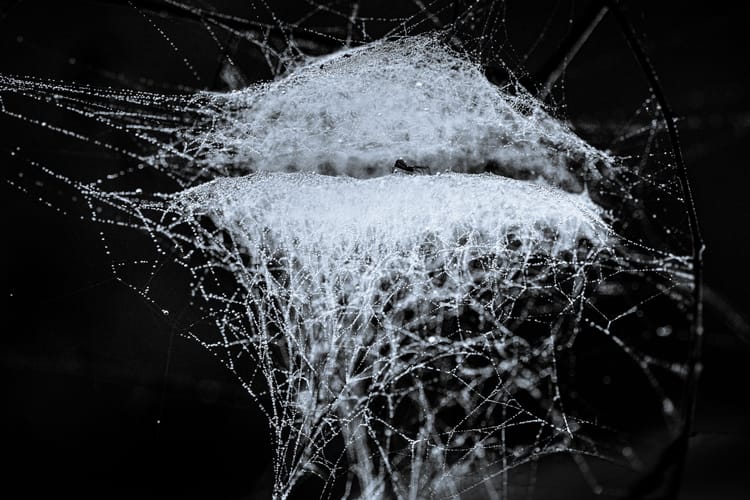13. Colleen M. Farrelly ~ crossing paths

As confluence begins its second year and introduces eight new Fellows from across the globe, we also welcome other new changes to this contemporary and exploratory journal. One big change we are especially excited about is the initiation of the confluence Council. This group of highly experienced poets will provide advice and mentorship to the current Fellows, as well as to the editorial team. The inaugural Council includes:
- Allyson Whipple
- Billie Dee
- David Oates
- Kala Ramesh
- Michael Ketchek
- Pravat Kumar Padhy
- Yvette Nicole Kolodji
We are deeply grateful to these distinguished poets for joining confluence in this way, and we look forward to collaborating with them over this coming year.
The same spirit of growth and experimentation animates the poetry of this issue. Colleen M. Farrelly's work reminds us that Japanese short forms in English can expand beyond the beyond of what we know these forms to be.
“I paint what cannot be photographed, that which comes from the imagination or from dreams, or from an unconscious drive…"
—Man Ray
From senryu to haibun, Farrelly knows her craft. She relies on the poetic devices found within haiku, senryu, and haibun to not only bend the rules, but break them entirely. In Farrelly’s work, you will find traditional tools, such as kigo, kireji, juxtaposition, toriawase, poignant shifts, and clever puns, as well as experimentation with surrealism. In these poems, which seem to come from both the unconscious and a stream of consciousness, she combines not only her passion for mathematics and art, but these philosophies as well. Farrelly applies several fully-developed and well-researched scientific and mathematical ideologies to her poems in a way that will wholly engage her audience. Her poems should both invite mathematicians into the creative world of poetry, as well as encourage a new generation of poets to delve deeper into the mathematical and scientific terms found within her work. Although many of these poems are sci-ku, or science haiku, they still impressively reflect the author’s individual and authentic experience. Farrelly’s poetry, which also expands into social justice, urban haiku, and Millennial slang, is both enlightening and necessary to shift perspectives. She writes what cannot be photographed… or painted.
Rowan Beckett Minor, confluence associate editor
poems
A Tale of Twilights
The sunset swirls around me as oaks shed their last leaves. A gray squirrel curls into its drey, and a barred owl hoots from a beech branch abutting the river. A hiker group snaps their last photos from the cedar viewing deck.
They head home, but I wander deeper into the night.
Crossing Paths
She puts out the bonfire and locks up the cabin before her evening jog. The last of the smoke curls around the falling oak leaves. A hint of apple cider lingers in the crisp breeze.
The air is dry, and the river runs low. She might see salmon spawning tonight.
Necessary and Sufficient Conditions
In topology, cobordisms relate feature changes between a start space and an end space.
water tumbles
over a glacier waterfall
For instance, two circles might merge as they evolve in time.
they link hands
as a brisk breeze
rustles the evergreens
Critically, cobordisms rely on boundaries to define a relationship.
she pulls away
autumn dusk Schrödinger’s cat on the fence
quantum mechanics
he’s uncertain
my car can be fixed
passing satellite
I make a wish
anyway
the cycles
of bipolar
sine wave
string theory
my tabby
unwinds a sweater
nuclear fission
my attempt at small talk
melts down
countably infinite
my alumni email
ends
black hole
his memories
escape
ecdysis I shed my layers of grief
guitar riff
wailing in the night
a teen banshee
haunted basement a sock ghosts the washer
tramp stamp
ICE leaves a bruise
on her back
shooting stars—
the dash between
born and died
graffiti
scrawled in the twilight sky
bare oak branches
snow angels
they find her lying
on her park bench
autumn breeze turning over a new leaf(blower)
the last leaf
catches in an eddy
situationship
flamingo flock
packing a soda lake
alone on shore
I avoid
the mainstream culture
#FemkuMag
Failed Haiku
Five Fleas Itchy Poetry
Fresh Out
Frogpond
H. Gene Murtha Memorial Senryu Contest, 2019
MacQueen’s Quinterly
MacQueen’s Quinterly Cheribun Challenge, 2025
essay
from tradition to innovation
Good poetry and innovation rely on craft fundamentals. Within haiku, kireji breaks the juxtaposition of images and serves as a pivot much the way a volta turns a sonnet. Within haibun and other hybrids, imagery, prosody, rhythm, sentence length, and even rhyme combine to evoke emotions and settings that interact with the title and haiku/Cherita/tanka. Without meticulous consideration of craft, innovation falls flat.
Fresh juxtapositions, split/diverging narratives, and blending of mediums provide a rich experimental setting. Recently, I’ve seen haiga-like poems in journals like Maintenant, which focus on Dadaism works; there’s no reason Cherita can’t blend with a collage or multimedia piece of art. Haiga sequences might incorporate spoken word over time-lapse photography or video.
Recently, haibun has undergone a renaissance of innovation as poets swap prose for formal or free verse, experiment with concrete forms, incorporate experimental monoku or surreal elements, and provide divergent endings to their narratives. Innovations in form and blends with other literary traditions catapult haiku, haiga, and haibun into the general literary community. As many luminaries age, the forms can survive by attracting young voices and incorporating contemporary literature trends.
As an art, poetry bears witness to the times and transcends narratives pushed by those in power to tell everyone’s stories. My own poetic heritage originates with WWI poets like Siegfried Sassoon and Wilfred Owen, as well as prose writers like Vera Brittain. Many poets of this era innovated for effect; Wilfred Owen incorporated slant rhyme to recreate the eeriness of warfare during that era. Modern poets like Terrance Hayes innovate within form to capture the essence of their own communities.
As a citizen, I belong to many communities. I’ve lived and volunteered in America’s inner cities, worked on health initiatives in Africa, witnessed the mental health crisis of combat veterans, and lost many loved ones when I was young. I work across many branches of science as a mathematician. I live in Miami, FL, where we mix many Caribbean cultures familiar in my youth. Tinkering with poetry helps me capture my experiences and my many communities.
When I imagine the next decade of my life, I see writing communities cross-pollinating, learning from each other, and inventing new forms to capture the diversity of lived experiences. Everyone deserves a voice, and we all have something to learn from one another.
While perusing Lewis Turco’s The Book of Forms to experiment further in 2018, she came across haibun and the haiku community, where she found a home. She’s published over 300 poems, including over 100 haibun/hybrids. Some of her awards include a 2014 Best of Vine Leaves Literary Journal award, an honorable mention in the 2019 H. Gene Murtha Memorial Senryu Contest, a 2022 Contemporary Haibun Online Anthology haiga inclusion, a 2023 Dwarf Star Award finalist finish, a 2024 Red Moon Press Anthology inclusion, a 2024 The Haiku Foundation re:viral inclusion, and placements in 2025 contests to be announced later this year.
Her mathematics papers appear in top medical journals, and her products have won a Gold Stevie Award, an EdTech Breakthrough Award, and a High Tech Award. She’s published two mathematics textbooks, worked on two Ebola outbreaks, and mentored a dozen graduate students in Sub-Saharan Africa.
You may find out more about Colleen at: www.linkedin.com/in/colleenmfarrelly
commentaries from Fellows
Cynthia Bale, Vidya Premkumar, & Margaret Walker
Cynthia Bale
Colleen M. Farrelly’s poems use both their form and their content to offer the reader expansive realms to explore. Her monoku “autumn dusk” offers three separate images of liminality – the moment between light and darkness in a season of transition, the theoretical cat who is simultaneously alive and dead, and the idiom “on the fence.” On my first reading, however, my mind also chose to group the last four words together and present me the literal image of a cat standing on a fence like a Halloween illustration come to life, which has insistently endured through all my subsequent readings of the poem.
Many of Farrelly’s poems also invoke spaces or absences as a way to create this room for the reader’s interpretation; in “shooting stars”, there is dreaming room both around and inside “the dash between born and died” – who was this person, and how did they spend their life? Similarly, in “nuclear fission”, we are invited to imagine just how the speaker’s small talk went awry, possibly even filling in our own personal experiences.
This openness is most evident in Farrelly’s haibun “A Tale of Twilights,” where the title’s unusual pluralization immediately alerts the reader to the multiple interpretations available. The prose offers us several different images to consider before the multiku opens into a kaleidoscope of options – which hiker’s camera lens to look through, and in which direction, both literally and figuratively? This emphasis on diverging paths is emphasized further in the closing line, where the others turn back but the speaker presses on – a choice that leaves the reader’s imagination free to roam beyond the bounds of the page.
Vidya Premkumar
Colleen Farrelly’s works are a delightful and intellectually curious fusion of precise observation and formal play, and they pivot between reason and wonder, proving that logic and lyric can coexist. Her background in mathematics and computational thinking lends many poems a structural logic where metaphors and images snap together with a satisfying pivot. Her haibun and linked short pieces riff on cobordism and quantum images and use scientific language not as ornament but to reframe intimate moments. She makes technical concepts living and tactile so that a glacier waterfall becomes a human tumble, or a string theory collapses into a tabby unwinding a sweater. There is also subtle humor, lighting the weightier lines and inviting rereading.
Her senryu demonstrates an ease with humor and irony, yet they never lose empathy. The balance between the analytical and the lyrical in her work makes her poems feel alive with dual awareness of the mind’s curiosity and the heart’s vulnerability. Pieces such as her “science-senryu” series and her haibun exploring topology and quantum imagery reveal an artist unafraid to experiment with form while remaining faithful to the haiku spirit of brevity, resonance, and implication.
If there is room for refinement, it would lie in letting the haiku moments breathe a little more within the prose, allowing emotional revelation to arise more by implication than explanation, and perhaps trimming the scientific preamble to make it more suggestive, less expository. Varying rhythm and melody from analytical to elegiac could create a more haunting shift in tone in the haibun and hybrid pieces.
Farrelly’s work is luminous, original, and thought-expanding, and a vital example of how intellect and imagination can coexist within the brevity of haiku and haibun.
Margaret Walker
Colleen M. Farrelly’s poems are unique. Several held words of science and physics, unfamiliar to me. I found I had question after question – beyond the unfamiliar scientific terms.
Her haibun intrigued me. In "A Tale of Twilights" the grid captures my attention. I conjecture what’s left unsaid in the prose. And why is "Twilights" plural?
The haiku grid makes me wonder what I might be missing. It’s surely saying more. If haiku is art, maybe the format needs no purpose other than to engage the reader to delve deeper into the poem.
Reading the next two haibun, I wondered if the three haibun comprise a set or is that my romantic imagination? Is “Crossing Paths” a continuation of “A Tale of Twilights”?
It is "Necessary and Sufficient Conditions" that most intrigued me. The three sets of prose are connected as expected – as are the three haiku. But it is the last line of the split tanka that leaves this reader wondering: she pulls away
I googled “cobordisms”. Without fully understanding the definition it makes me wonder. Who and what are the areas of convergence? The title and last line alone tell a story:
Necessary and Sufficient Conditions
she pulls away
I recall one of the haiku from its original publication:
snow angels
they find her lying
on her park bench
Are the “snow angels” children playing in the snow who find a homeless woman? Is the writer one of the snow angels who finds her and does angels imply that the woman has died? Is this a poem about the homeless in our country and the world?
In short, her work often had me asking questions that drew me in, and made me wonder.
Thank you for reading! We invite you to continue the conversation by hitting the "comment" button below. Feel free to share your favorite poem of Colleen's or your reactions to her work. Colleen and the editors look forward to reading and responding to your comments.
If you liked the issue, we also welcome you to share this with others in your community. Stay tuned for the next issue later in November, which will feature work by Fellow Cynthia Bale.






Member discussion